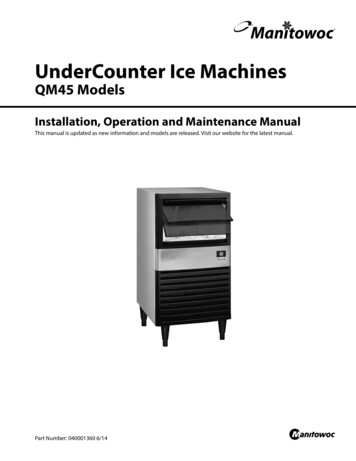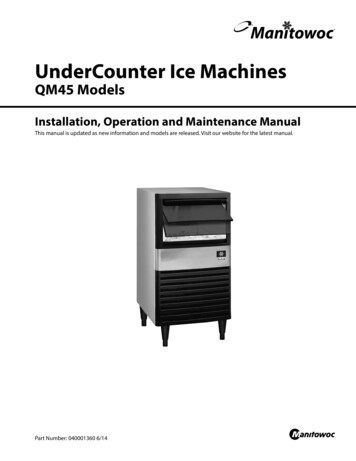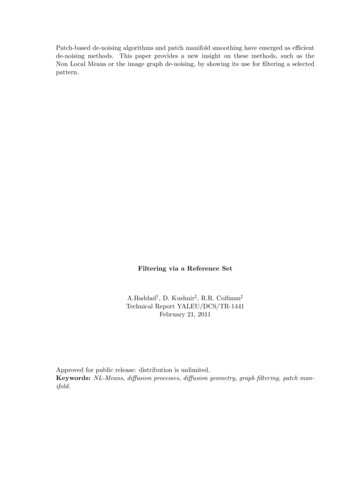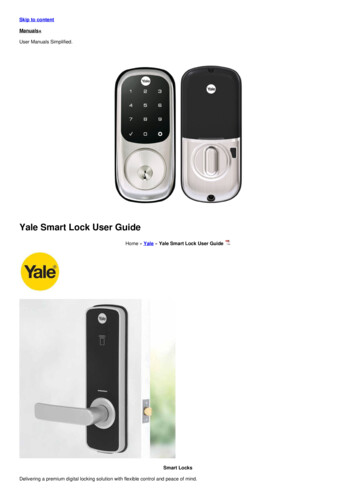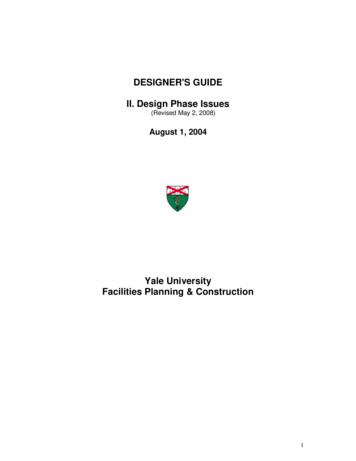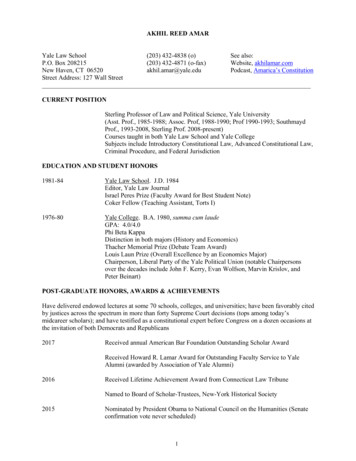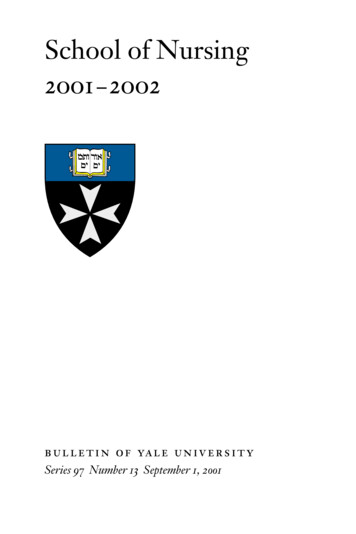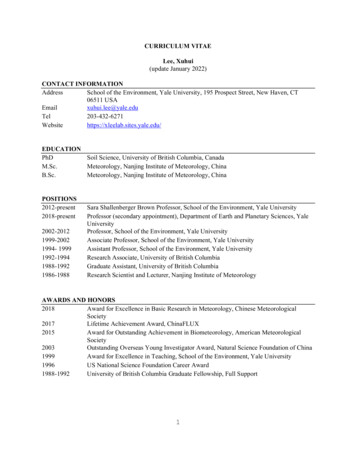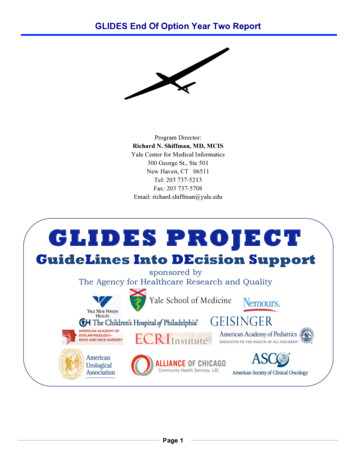
Transcription
GLIDES End Of Option Year Two ReportProgram Director:Richard N. Shiffman, MD, MCISYale Center for Medical Informatics300 George St., Ste 501New Haven, CT 06511Tel: 203 737-5213Fax: 203 737-5708Email: richard.shiffman@yale.eduGLIDES PROJECTGuideLines Into DEcision Supportsponsored byThe Agency for Healthcare Research and QualityPage 1
GLIDES End Of Option Year Two ReportIntroductionOverview Of GLIDES Approach To Clinical Decisions SupportThe GLIDES Project (GuideLines Into Decision Support) is a collaboration of guideline developers, disseminators, andimplementers working to design, develop, implement, and demonstrate clinical decision support (CDS) applications usingsystematic and replicable processes for knowledge transformation and CDS design. GLIDES was commissioned by theAgency for Healthcare Research and Quality (AHRQ) in February 2008, and is now completing its fourth year ofoperations. The objective of the GLIDES project is the development, implementation and evaluation of demonstrationsub-projects that advance understanding of how best to incorporate clinical decision support (CDS) into the delivery ofhealthcare. The project is exploring how the translation of clinical knowledge into CDS can be routinized in practice, andtaken to scale, to improve the quality of healthcare delivery in the U.S. Following an initial two-year AHRQ contract topursue this objective, GLIDES has now completed two additional Option Years of demonstration work.GLIDES believes it is necessary to pursue improvements across several dimensions of the guideline development andimplementation process. GLIDES envisions these dimensions as entGenerationOf RecsWorkflow(Re)designBuild &Test Knowledge Formalization is theprocess of translating narrativeguidelines into structuredknowledge that can beimplemented consistently asautomated CDS. Knowledge Integration coversthe activities necessary to designand build a local CDS solution. Knowledge Implementationincludes project organization,management and evaluationactivities necessary to implementthe CDS in clinical settings.CrosswalkLogic reate RulesAction TypesKnowledgeFormalizationKnowledge Generation is theprocess of creating guidelines thatcan be implemented effectively.UI DesignAppraiseImplementabilityGLIDES4 DiamondApproachTo CDSDesign Roll-Out &EvaluationGoals &InterventionsWork Plan &ControlGovernance &OrganizationKnowledgeImplementationFigure 1. GLIDES Dimensions Of Guideline Knowledge ManagementA centerpiece of GLIDES strategy is the Guideline Elements Model (GEM). GEM is an XML-based knowledge modelfor guideline documents. It incorporates a set of more than 100 tags to categorize guideline content. Initially published asa Document Type Definition (DTD), it was successfully balloted as a standard by the American Society for Testingand Materials (ASTM) in 2002. In 2006, the model was updated as GEM II, published as an XML schema, and againaccepted as a standard (E-2210-06). A third revision is currently undergoing consideration of standardization. GEMprovides a bridge between Knowledge Generation and CDS implementation and provides the backbone tools forKnowledge Formalization.Page 2
GLIDES End Of Option Year Two ReportOption Year Two GoalsThe following goals formed the basis of GLIDES’ Option Year Two (OY2) initiatives and project plan:1. Using systematic and replicable processes, we will continue to design, develop, implement, and demonstrateguideline-based clinical decision support. This will focus both on new guidelines and implementationpartnerships, as well as enhancing and improving the CDS already produced at Yale, Children’s Hospital ofPhiladelphia (CHOP), and Geisinger. Focus more closely on consolidating the successful practices and lessons learned into a formal set of tools andmethods that is systematic, replicable and documented. Continue to fund completion of implementation activities, while increasing interaction and collaboration amongimplementation partners to add insight and crystallize key conclusions and lessons learned for CDS development. Engage additional advisors and experts in specific areas of controversy to add value and perspective.2. Recognizing the critical importance of transparently developed and clearly stated guideline recommendationsfor effective implementation, work closely with guideline developers to provide tools and guidance to improveguideline development and reporting processes. Continue to work with the American Academy of Pediatrics (AAP) and the American Academy ofOtolaryngology-Head and Neck Surgery (AAO-HNS) to integrate BridgeWiz and GLIA tools into their guidelinedevelopment processes. Expand our focus to additional guideline developers, potentially including such developers as National Heart,Lung, and Blood Institute (NHLBI), the American Thoracic Society (ATS), the American Urological Association(AUA), the American Society of Clinical Oncology (ASCO), the American College of Emergency Physicians(ACEP), the American College of Chest Physicians (ACCP) and Developing Evidence to Inform Decisions aboutEffectiveness (DEcIDE). Formalize the recommendations and then focus on dissemination to other guideline development organizations,with emphasis on promotion of software tools.3. Update the Guideline Elements Model and increase GEM adoption nationally and internationally. Focus on completion, standardization and promotion of the new GEM release. Focus on how BridgeWiz and GEM can be integrated. Work with the ECRI Institute and Silverchair to demonstrate how GEM-encoded guidelines can be disseminatedthrough the National Guidelines Clearing House (NGC). Work with other AHRQ knowledge representation projects, in a spirit of best practice sharing.4. Continue evaluation of both existing and newly developed CDS implementations. In OY2 GLIDES will continue evaluation activities across each of the collaborators, and production of associatedpapers.5. Disseminate the findings and lessons learned via a variety of modalities. In OY2 GLIDES will provide more opportunities for collaborators to share their results and lessons learned (TEPparticipation, papers, etc).Page 3
GLIDES End Of Option Year Two ReportOption Year Two Accomplishment SummaryGLIDES investigators delivered on our goals and commitments in OY2, and were able to do so within our OY2 budget. GLIDES worked with four leading healthcare delivery organizations — Geisinger, Children’s Hospital ofPhiladelphia and Alliance of Chicago — to implement Clinical Decision Support demonstration applications. Yaleimplemented a major enhancement to the Asthma CDS previously delivered by GLIDES, which automates the directcapture of patient information during the registration process, using iPad technology. CHOP implemented CDSapplications for management of premature infants. Geisinger implemented CDS applications for management of LowBack Pain and began to pilot an audio-recording application that captures and evaluates feedback from patientencounters and integrates it into the CDS flow. Finally, Alliance implemented a version of Yale’s Asthma CDS,customizing it to meet their local workflow and clinical needs, thus examining the challenges of local customizationand implementation. GLIDES worked with four national guideline development organizations — AAP, AAO-HNS, AUA and ASCO - todesign, implement and pilot processes and tools intended to make guidelines clearer and more implementable.Specifically, these tools include the automated guideline-authoring tool – BridgeWiz – and the GuidelineImplementability Appraisal tool (GLIA). In OY2, we continued to refine and enhance these tools, incorporatingfeedback from the collaborations. Regardless of the infrastructure chosen by guideline implementers to design anddeliver CDS, these tools for guideline developers can enhance the “implementability” of medical guidelines andpolicy statements. Continued to leverage and enhance the GEM toolset, incorporating lessons learned back into enhancements andimprovements to a new version of GEM –GEM III. This release incorporates more granular concepts of knowledgecomponents and new elements and attributes of codes and codesets. It also features integration with BridgeWiz,whereby guidelines authored in BridgeWiz can be stored in the GEM XML structure, to assist with implementation.GEM III has been submitted and balloted at ASTM International.Page 4
GLIDES End Of Option Year Two ReportCDSImplementationResultsCHOP CDS Implementation (Task 2.1)CHOP pursued several opportunities with CDS demonstration projects in OY2, including: moving beyond alerts andreminders; providing the correct level of decision support; and understanding factors beyond the user interface. In OY2,CHOP also assessed current clinical workflow processes and identified opportunities to improve them with sTask2.1.1ActivityComplete Final CDS Development and Testing Complete Final Release Development Perform Use Case Testing Perform Final Usability Testing Deployment OP)/SynagisReleaseUse CasesUsability Testing StatusofofRespiratory syncytial virus(RSV)/Palivisumab delivered(10/11)ROP/Synagis delivered (2/12for trial, full release 3/12)2.1.2Post-Deployment Assessment Initial Evaluation Interim data analysisIn process as planned – willbe completed in OY32.1.3Dissemination Implementation Guide Technical Appendix ImplementationGuideTechnical AppendixDocuments delivered (will beincluded in GLIDESRepository for OY3) SpecificAccomplishmentsCHOP implemented a CDS application for management of premature infants – the Premature Infant Assistant - whichutilizes real time Electronic Health Record (EHR) data mining and is integrated with a rules-based expert system andcustom EHR application framework. The CDS application was applied to two clinical guidelines (policy statements) fromthe American Academy of Pediatrics: Respiratory Syncytial Virus and Palivizumab and Retinopathy of Prematurity(ROP). GEM was used to transform the policy statements into more than 100 rules, applied to 30 patient variablesextracted from the EHR.Highlights of the CDS functionality include: Growth and Nutrition: Real time assessment of growth and tools to create feeding recommendations and education Development: Assess/monitor documentation of development and provide automatic age-corrected developmentdocumentation tools in the EHR. Blood Pressure Screening: Recommend screening at corrected age, plus data mine EHR for any abnormal readings inpast and recommend screening.CHOP followed a user-centered development process to design and build the CDS applications, with extensive use casedevelopment and validation. Multiple and iterative user interface and workflow design sessions were performed,Page 5
GLIDES End Of Option Year Two Reportinvolving over 25 clinicians. Extensive usability testing was performed on the functioning system. CHOP responded touser feedback and made user interface/workflow changes to improve usability/utility.CHOP created an extensive implementation guide detailing the overall architecture and development process used,including a technical appendix with system diagrams, supporting files and libraries.CHOP performed an initial analysis of outcomes and usage data. Initial results focus on usage and findings on RSV anddelays in administering dosing of Palivizumab. In addition, CHOP compiled premature infant parent education contentand developed a Portable Document Format (PDF) generator integrated with the EHR programming framework to autogenerate patient specific education materials from the EHR.Independently, Jeremy Michel at Yale marked-up the Palivizumab guideline and developed a rule set for it, working withthe CHOP team to reconcile the differences. This exercise was useful in identifying ambiguities with significantconsequences and demonstrating how two different knowledge translation processes can generate different results.EvaluationFindingsEvaluation of the CDS applications is in progress and will be completed in OY3. Initial evaluation highlights include: Differential interpretation of the policy state on Palivizumab administration would result in significant and costlydifferences in the eligible pool of patients. The RSV Care Assistant was deployed to twenty general pediatric practices and was used to help manage the care of343 patients in the first two months of the post intervention RSV season. Analysis of the subgroup of 131 children eligible to receive monthly Palivizumab for the entire RSV season revealedthat 112 (85%) had received at least one dose by 12/31/2011. By comparison, among a cohort of 119 children eligible to receive monthly doses for the prior RSV season, only 69(77%) had received at least one dose by 12/31/2010 (p .095).Barriers,RisksandIssuesAlthough CHOP investigators were able to deliver all planned work products, the implementation of the CDS applicationswas delayed during the course of OY2 to allow more time for user testing and incorporation of usability improvementsidentified during CHOP’s user-centered development process. Specific delays were due to high complexity of rules andanalysis of free text notes in the EHR. Specific challenges included: Clinician Acceptance/Buy-In: In particular, gaining clinician agreement that CDS is needed for the identifiedpatients/issues and their commitment to use and adopt the CDS prior to implementation. To achieve this, CHOPinvestigators communicated closely with clinicians prior to development, engaged high-level stakeholders andengaged clinicians and stakeholders closely in their user-centered development approach. This approach, whilenecessary to ensure a high quality design, also creates a subsidiary problem: the need to recruit busy clinician subjectsfor user-centered methods/activities.Page 6
GLIDES End Of Option Year Two Report Guideline Ambiguity/Gaps: CHOP’s work demonstrated again that published guideline documents will often notprovide complete coverage for logic implementation. To resolve this, CHOP formed a clinician expert panel toreview, research and (where required) make informed decisions to address any ambiguity or gaps in the documenttranslation. Inconsistency Of EHR Data: CHOP’s project needed to resolve data quality problems inherent in the EHR system thatimpacted the CDS design. Some required data was either missing, in different locations and/or in different formats. Toaddress this, CHOP performed analytics/reporting prior to development to test and validate the required data sourcesand queries. In addition, extensive data testing was performed early in the system development process and a limited“beta” release was introduced to a small group of clinicians to pilot the design in real world clinical environments.Geisinger CDS Implementation (Task 2.2)In OY1, GLIDES provided funding, tools and support for use of GEM to codify the Institute for Clinical SystemsImprovement (ICSI) guidelines on primary care management for back pain. The coded guidelines were used to aid indesigning the electronic patient questionnaire. Geisinger applied GEM to these guidelines to codify them for real time usein clinical practice. In OY2, GLIDES provided funding and support for expanding the coded guidelines to translate intorules for real time application of management recommendations based on patient reported data on back pain. This isdisplayed in the clinical decision support web display to the provider in the exam room. In addition, Geisingerinvestigators are audio-recording the patient-provider dialogue of consenting patients randomized to the eLowBackPainintervention group and consenting patients randomized to the usual care group. The audio recordings are being evaluated,using the Roter Interaction Analysis System (RIAS), to identify and assess differences for patients in the interventiongroup versus the usual care group. (Note that funding for the implementation of the eLowBackPain application itself wasnot supplied by GLIDES – GLIDES funding was used to support the audio-recording-related enhancements 2.2.12.2.22.2.32.2.4ActivitySelect Appropriate Instruments for AudioAssessment Determine requirements Research potential options Select option/approach Prepare design specificationsDevelopment and Approval Develop consent screen process and language Obtain system compliance and approval Obtain IRB approvalInstall In Clinic Install devices Install software Go-liveTranscription and Analysis Obtain patient consents and performrecordingsPage 7Deliverable System designTechnology selection Consent language/design Accomplishment ofSystem InstallationmilestoneInitial data analysisof recordings andtranscriptionsStatusCompleteCompleteCompleteIn progress – to be completedin OY3
GLIDES End Of Option Year Two Report Perform transcription and coding analysisComplete data analysisSpecificAccomplishmentsIn OY2, Geisinger introduced the audio-recording protocol in one of the five clinic sites and will consider implementationon other clinic sites in OY3. Geisinger investigators commenced work on the transcription and analysis activities in OY2.Approximately 25% of the patient consents and recordings and transcription and coding analysis work was completed.The balance of this work, and related evaluation, will be completed in OY3.Barriers,RisksandIssuesImplementation of the e-health back pain sponsored protocol in primary care was delayed by three months, which had afollow-on impact on the delivery of the audio-recording enhancements. To accelerate enrollment and fulfill support fromthe Geisinger system, the team expanded and implemented the protocol to four additional clinic sites by the end ofJanuary 2012. Particular challenges included: Institutional Review Board (IRB) Approval: Geisinger were required to submit a separate IRB application for theAHRQ funded work. They originally submitted an amendment to the original study, but the sponsor concluded thattheir protocol review would not accept that method of approval. While Geisinger do not anticipate any problems withgaining approval for a separate IRB application, additional time and effort was required to assemble and submit theapplication for review. Technology: The Geisinger IT team had to create a new classification on the exam room computers to account for therecording software and microphone. This had to be added to the classification setup used for the e-health back painprotocol and tested to make sure it was secure and the necessary components were locked down for patient use.EvaluationFindingsThe objective of OY2 was to determine if the e-health back pain protocol resulted in superior dialogue and shareddecision making between the patient and provider. Patients and providers who consented would be audio recorded duringthe back pain visit and their recordings would be evaluated by an expert team using a well standardized protocol forcoding and rating the quality of the doctor-patient interactions. This evaluation work is now in progress, which includesthe transcription and analysis activities noted above. This work has not yet progressed to a stage where specificevaluation findings can be drawn. This work will be completed in OY3.Yale Patient-Centered Data Capture (Task 2.3)GLIDES investigators and Yale New Haven Health System Information Technology experts collaborated on a CDSinitiative for patient-centered data capture using iPad tablets. This initiative was designed to address a major finding fromthe Asthma CDS implementation and evaluation: namely that pulmonologists avoided using the CDS in real time bymaking notes on a paper based clinical inventory. The patient-centered data capture project examines whether CDSavoidance can be overcome when patients enter interim history (necessary to trigger decision support) on a tablet and theinformation is only available for review within the EHR/CDS. In OY1, an initial version of the application was deployedPage 8
GLIDES End Of Option Year Two Reportin the Asthma Specialty clinic at Long Wharf, in New Haven CT. In OY2, Yale continued to evaluate and improve thepatient-centered data collection 2.3.12.3.22.3.3ActivityOptimize Current Pilot OperationEvaluate Current Pilot Finalize evaluation plan Perform patient surveys and interviews Perform evaluation studiesConsider Expanding Pilot For OY3DeliverableOptimized pilot systemEvaluation PlanReview of registrar logsDesign proposal forVersion 2.0 and OY3StatusCompleteIn process – to becompleted in OY3CompleteSpecificAccomplishmentsThe pilot application was enhanced and improved. Technical performance was improved, in areas such as security,performance and integration with IDX. Functional performance was also improved, in areas such as access to informationtypes and access to the patient registry. Appointment registry data is now fed from the clinic's IDX system (GE Health,UK) to insure accurate patient identification before receipt of the device in the clinic waiting room. A series of multiplechoice questions (English or Spanish) are displayed on the iPad and answered by tapping on the desired answer. Uponcompletion, responses are sent wirelessly over the secure clinic network to the web application server, creating a labHealth Level Seven (HL7) message with patient responses as observation terms. This information is then sent to theenterprise interface engine (eLink) and directed into the Centricity EHR.A document outlining complexities incident to the use of patient-centered data collection devices in an enterpriseenvironment is being drafted. Preliminary design work on enhancements for a new release of the tablet application, to bedelivered in OY3, is in progress.Barriers,RisksandIssuesThe main challenge was how to acquire hardware (iPad equipment) to expand the pilot. The pilot is currently functioningin the Yale Long Wharf clinic, with three clinicians using the application regularly. We could extend the pilot for use atYale’s main pulmonology clinic in New Haven. It could also be implemented at other primary care clinical locations atYale. However, the terms of the GLIDES contract do not allow for acquisition of new hardware.EvaluationFindingsAll of the pulmonologists at the Long Wharf expressed satisfaction with the system. Prior concerns regarding additionalburdens on the registrar staff (responsible for distribution of the iPad devices) did not materialize. Patients were able touse the system with minimal training and expressed satisfaction.Since iPad pilot initiation, 116 patients have been seen for asthma: 111 (95.7%) patients were willing and successfullyused the iPad application without any formal training or orientation to the device. Five (4.3%) patients declined to tryPage 9
GLIDES End Of Option Year Two Reportusing the device. Server problems resulted in 14 (12.1%) lost transmissions but the root cause of these problems werepermanently corrected in OY2. Overall, 97 (83.6%) patients had successful completion and transmission to EHR ofasthma interval history into Centricity from the iPad application.In March, the Yale team developed a poster summarizing the project’s results, for presentation at the upcoming PediatricAcademic Societies Conference. The posted is entitled: Pediatric Asthma History Review By PatientsUsing iPads: Challenges & Adoption. The poster notes that: “While there are many technical and security steps toconsider, an easily adopted, touchscreen graphical user interface device, such as an iPad can be used to successfully andsecurely collect and transmit data into an EMR. Provider and patient enthusiasm was extremely positive”.Add New Implementation Partner (Task 2.4)In OY2 GLIDES began work with a new implementation partner, Alliance of Chicago, to implement clinical decisionsupport interventions in OY2 and OY3. Alliance investigators planned to use the Yale-site designed Asthma CDS. Theyintended to customize and reuse it for implementation across the Alliance network, carefully noting barriers andfacilitators of transferring a working CDS from one site to another where both sites use the same vendor-supplied EHR(GE’s Centricity).We were able to make significantly more progress than planned with this task. Our original goal was to organize theproject, for delivery in OY3. However, the Alliance team was able to mobilize to perform design and development workin Q4 2011 and Q1 2012. Software and technical support were provided to Alliance to initiate development.Consequently, most of the application development and testing work for the CDS will be completed in OY2, allowingAlliance to focus on roll-out and evaluation work in 4.12.4.22.4.3ActivitySelect and build implementation / demonstrationpartnership Work with AHRQ to organize criteria for screening andselection of potential partner institutions Evaluate partnership short list against screening criteria Recommend organization for new partnership Organize partnership project Engage relevant partnership personnel in project Review partnership plan with AHRQ for approvalSelect guidelines and conditions for implementation Agree clinical objectives for implementation Identify quality gaps that might be addressed by guidelinebased decision support systems. Agree methodology/criteria for selection of guidelines andrecommendations Review selection and guideline plan with AHRQEstablish Project Governance and Organization Identify key stakeholders and guideline champions Agree project management arrangements/methodsPage 10DeliverableCriteria for screeningand selection ofpotential partnerinstitutionsStatusCompleteRecommendations fornew implementationpartnershipRecommendations forguidelines to beimplementedProject organizationchartCompleteComplete
GLIDES End Of Option Year Two Report2.4.4 Complete implementation project kick-offOption Year Three Planning Prepare plans for completion, implementation and rolloutActivities and budgetsdocumentedandpresented to AHRQCompleteSpecificAccomplishmentsAlliance investigators were able to successfully adapt the CDS content from Yale. Revised CDS forms (and additionalcontent such as Handouts for Asthma Action Plan and Asthma Control Test) were developed and reviewed by Alliancesubject matter experts. Form and content is currently being reviewed by usability testers, who are providing feedback.Although Alliance was able to work within the overall framework and structure of the Yale CDS, several detailed changeswere incorporated into Alliance’s version of the EHR “Asthma Management Form”. These various changes illustrate thetypes of “on the ground” changes needed to customize a CDS application to allow it to operate effectively from oneclinical context to another: The Control and Severity Form was added as a single tab in the Alliance Asthma form. This required:o Navigation changes: Removed radio buttons to select “visit type”; Removed radio buttons to jump to otherforms; Added display to show previous Severity to enable providers to better select if Severity has beenassessed; Added simple option to document Severity Classification in the case it had been determined by aprovider prior to patient being seen in the clinic; Updated chart note translation to be easier to read and toreflect if both Control and Severity were documented in a single visit.o Changes to the look and feel of the Control/Severity including: Shortening the descriptions of some questions,adding popup buttons to offer the additional information that was removed; Added functionality to haveprovider accept the Control Assessment and the Severity Assessment; Shortened some responses to fit intoavailable space (this resulted in the need to modify the ‘calculation’ to determine Control and Severity);Added pop up buttons with help in use of the form.o Functions to be updated to remove logic related to EHR document summary lines specific to Yale workflows:The Yale workflows had specific Encounter types for new Asthma visits that would default a specificsummary line, thus triggering functions to load. Since Alliance cannot rely on a standard Encounter type usedby all sites, this logic had to be removed and developed elsewhere; Text Components getting loaded into theupdate based on the summary line had to be moved to Visual Form Editor function library so that the librarywould be loaded whenever the form was added to any update. Changes to the Medication form: Removed radio buttons to select visit type; Removed radio buttons to jump to otherforms; Updated look and feel to match Alliance Standard (button colors and fonts); Removed Refill buttons fromindividual lines and added a global button at the bottom of the tab; Functions moved to Visual Form Editor functionlibrary; Updated Text Files with new GPI codes to ensure all medications are added when selected; Updated functionsto check if medication already on medication list and prompt user to update the medication list; Updated logic to addmedications to observation terms. Changes to the Assessment Form: Removed radio buttons to select visit type; Removed radio buttons to jump to otherforms; Updated look and feel to match Alliance Standard (button colors and fonts); Reduced size of ‘image’ to havetab without scroll bar; Removed items to display previous Control Classification, Impairment and Risk, and SeverityClassification, Impairment and Risk. The Alliance form has a summary page that displays this information. Addedjust display for classification of Severity and Classification. Updated logic for displaying recommendations toPage 11
GLIDES End Of Option Year Two Rep
utilizes real time Electronic Health Record (EHR) data mining and is integrated with a rules-based expert system and custom EHR application framework. The CDS application was applied to two clinical guidelines (policy statements) from the American Academy of Pediatrics: Respiratory Syncytial Virus and Palivizumab and Retinopathy of Prematurity .

